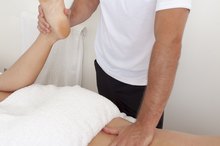What does fact checked mean?
At Healthfully, we strive to deliver objective content that is accurate and up-to-date. Our team periodically reviews articles in order to ensure content quality. The sources cited below consist of evidence from peer-reviewed journals, prominent medical organizations, academic associations, and government data.
The information contained on this site is for informational purposes only, and should not be used as a substitute for the advice of a professional health care provider. Please check with the appropriate physician regarding health questions and concerns. Although we strive to deliver accurate and up-to-date information, no guarantee to that effect is made.
What Is C4-C5 Spondylosis?
When arthritis occurs in the spine, the condition is called spondylosis. People with C4-C5 spondylosis have developed arthritis between the third and fourth cervical vertebrae of their necks 12. Cervical spondylosis can cause substantial pain and progress to point where patients become unable to raise their heads or control their limbs 12. Patients with less-serious cases of C4-C5 spondylosis can find relief with physical therapy and medications, but surgery to stabilize the spine may become necessary.
If you are experiencing serious medical symptoms, seek emergency treatment immediately.
Causes
Age-related degeneration of the bones in the neck and of the cartilage, or disk pads, between vertebrae sets the stage for cervical spondylosis 12. Damage from a neck injury can hasten the breakdown of cushioning between vertebrae, and little beyond avoiding injuries can be done to slow the onset of some degree of cervical spondylosis 12. The Mayo Clinic says that maintaining proper posture and regularly taking breaks from activities such as typing on a computer that involve holding the head at unnatural angles can keep the joints of the neck healthy.
Symptoms
Exercises & Treatments for Neck Bone Spurs
Learn More
Recurrent or chronic neck pain and stiffness can signal the onset of cervical spondylosis 12. These symptoms worsen and become more frequent over time, and the pain may spread down into the shoulders and arms. Patients may also have headaches.
Complications
As cervical spondylosis progresses, bone spurs may form on the parts of the vertebrae that rub against each other 12. Also, the compressed or tilted C4 and C5 vertebrae can impinge the spinal cord, creating numbness and weakness in their arms and legs, as well as occasional loss of balance. Patients with very advanced cervical spondylosis may lose bladder or bowel control or become unable to walk or move their arms 12.
Early Treatments
Causes of Pain in the Neck & Back of the Head
Learn More
Rest and exercises to strengthen the muscles of the neck constitute the first line of treatments for cervical spondylosis 12. Therapeutic interventions may advance to having patients wear a neck brace or lay in traction for a time to realign the vertebrae of the neck. Nonsteroidal anti-inflammatory drugs also play a role in treating cases of cervical spondylosis that do not require surgery 12. Severe pain may prompt prescriptions for cortisone injections, opioids and muscle relaxants.
Surgical Treatments
Patients showing neurologic impairment such as lack of bowel control will have surgery to remove any bone spurs and to relieve pressure on the spinal cord. As part of the surgery, patients may have bone and cartilage removed or have bone implanted.
Related Articles
References
- Cervical spondylosis from MayoClinic.com
- Cervical spondylosis from Medline Plus
- Blozik, E. Depression and anxiety as major determinants of neck pain: a cross-sectional study in general practice. BMC Musculoskelet Disord. 2009 Jan;10:13. doi:10.1186/1471-2474-10-13
- Lin SY, Sung FC, Lin CL, Chou LW, Hsu CY, Kao CH. Association of depression and cervical spondylosis: a nationwide retrospective propensity score-matched cohort study. J Clin Med. 2018;7(11). doi:10.3390/jcm7110387
- McCartney S, Baskerville R, Blagg S, McCartney D. Cervical radiculopathy and cervical myelopathy: diagnosis and management in primary care. Br J Gen Pract. 2018 Jan; 68(666): 44–46. doi:10.3399/bjgp17X694361
- American Academy of Orthopaedic Surgeons. Cervical spondylosis (arthritis of the neck). Orthinfo.com. November 2019.
Writer Bio
Ed Lamb is a freelance writer and editor in Virginia Beach, Va. He has written widely in the fields of health policy, pharmacy practice and pharmaceuticals. He has also developed expertise in the areas of employment law, human resources and product packaging and industrial food production.








